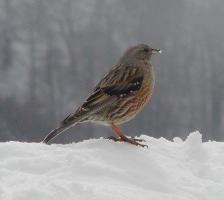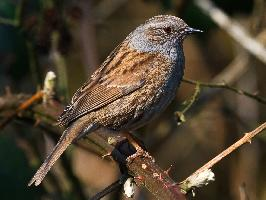
Popis zvířete
The Alpine Accentor, scientifically known as Prunella collaris, is a small, robust bird belonging to the family Prunellidae. This species is primarily found across the mountainous regions of Europe and Asia, thriving at altitudes ranging from 2,000 to 3,000 meters above sea level. The Alpine Accentor is uniquely adapted to its high-altitude habitat, displaying a blend of physical and behavioral characteristics that enable it to survive in harsh, cold environments.Physical Description:
The Alpine Accentor has a distinctive appearance that sets it apart from other members of the Prunella genus. It measures approximately 17 to 20 centimeters in length, with a wingspan of 22 to 29 centimeters, and weighs between 30 to 45 grams. The bird exhibits a striking plumage that is primarily a blend of brown, gray, and black, with subtle hints of orange and rust on the flanks and underparts. Its back is mottled brown and gray, providing excellent camouflage against the rocky terrain of its habitat. The throat is white, adorned with fine black streaks, and the breast features a unique speckled pattern. One of the most distinguishing features of the Alpine Accentor is its bill, which is robust and slightly curved, designed for foraging on a variety of insects and seeds.
Habitat and Distribution:
The Alpine Accentor is a resident of the high mountains, where it can be found amidst rocky outcrops, cliffs, and alpine meadows. It has a broad distribution, spanning several mountain ranges including the Alps, Pyrenees, Carpathians, and certain parts of the Himalayas. Unlike many birds, the Alpine Accentor does not typically migrate but may move to slightly lower altitudes during the winter months to escape the most severe weather conditions.
Behavior and Diet:
The Alpine Accentor is known for its hardy nature and ability to withstand the extreme cold. It is predominantly insectivorous during the warmer months, feeding on a wide variety of insects such as beetles, flies, and caterpillars. During the winter, when insects are scarce, it switches to a diet of seeds and small fruits to sustain itself. The bird is often seen foraging on the ground, using its strong bill to uncover hidden food sources beneath the snow and soil.
Reproduction:
Breeding season for the Alpine Accentor typically begins in late spring and can extend into the summer months. The species is polygynandrous, meaning that both males and females may have multiple mating partners during the breeding season. Nests are constructed in sheltered locations, often in crevices among rocks or in dense vegetation. The female lays a clutch of 3 to 5 eggs, which are incubated for approximately two weeks before hatching. Both parents share in the feeding and care of the young, which are able to leave the nest and fend for themselves after about three weeks.
Conservation Status:
Currently, the Alpine Accentor is classified as Least Concern by the International Union for Conservation of Nature (IUCN). The species has a wide range and a stable population size. However, like many high-altitude species, it may face future threats from climate change and habitat disturbance. Conservation efforts to preserve its mountain habitats are essential to ensure the long-term survival of this remarkable bird.
In conclusion, the Alpine Accentor is a fascinating bird species, embodying the resilience and adaptability required to thrive in the rugged, high-altitude landscapes of Europe and Asia. Its unique physical characteristics, intriguing behaviors, and the ecological role it plays in its habitat make it a subject of interest for birdwatchers and conservationists alike.
Podobná zvířata
Nové fotografie zvířat
Top 10 zvířat
- Chinese water dragon (Physignathus cocincinus)
- Galápagos tortoise (Geochelone nigra complex)
- Dolphin gull (Leucophaeus scoresbii)
- Japanese macaque (Macaca fuscata)
- Colombian red howler (Alouatta seniculus)
- Sea urchins (Echinoidea)
- Moustached guenon (Cercopithecus cephus)
- Diana monkey (Cercopithecus diana)
- Common reed warbler (Acrocephalus scirpaceus)
- Common house mosquito (Culex pipiens)
